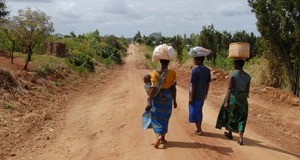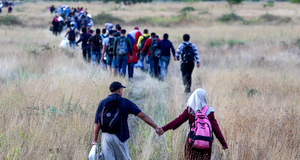Discussing Refugee Women: Speechlessness, Helplessness and Bodies-as-Facts
By
2015, Vol. 7 No. 08 | pg. 2/2 | « Bodies as Facts and Processes of SilencingThe core – the knot – of the issue, where the representations of refugee women, their gendered bodies, speechlessness and helplessness all come together, lies in the way we think of their bodies. Bodies, as I have just discussed, are seen as the place where speechlessness is confined and where one can locate the ultimate proofs of helplessness. But why is that? Cora Diamond's essay The Difficulty of Reality and the Difficulty of tackles the question of why it is that when confronted with a difficulty of, we tend to deflect this difficulty by turning bodies into facts (Diamond 2003, p.13). When faced with a difficulty of reality, we may not even know "how to treat a wounded body as anything but a fact" (Diamond 2003, p.13). Basing her inquiries on Diamond's problematised body as fact, Stevenson (2014, p.19) then asks "How does a wounded [..] body become a fact? Or, perhaps, better, what explains our thirst for [bodies as] facts [..]?" Stevenson (2014, p.19) finds an explanation in Betancourt-Serrano's links between facts and a certain calmness. There is calmness, he argues, because of the nature of facts. A fact is understood as something that is out there, awaiting discovery, uncontested and unchallenged. The "thereness" of a fact then is really its biggest claim to truth: facts are there, and this "thereness" negates any challenge made to their existence. In a similar way, the "thereness" of wounds on bodies of refugees are proofs that the persecution, to use the vocabulary of the Convention, is real. Nancy Scheper-Hughes and Margaret Lock examined the central role of the body in medical anthropology in an article titled The Mindful Body: A Prolegomenon to Future Work in Medical Anthropology.In this essay, they identify one of Western science's premises that state there exists "an opposition between spirit and matter, mind and body, and (underlying this) real and unreal" (Scheper-Hughes and Lock 1987, p.8). This Cartesian legacy that looks for causes of suffering in a palpable body has reinforced opposition between body and soul, and by extension real, physical sources of pain over psycho-social ones (Scheper-Hughes and Lock 1987, p.10). The refugee's body has thus become the place where persecution, violence, and suffering are inscribed (Fassin 2005). This inscription, Fassin (2005:, p.598) writes in The Truth From the Body: Medical Certificates as Ultimate Evidence for Asylum Seekers: "is an inscription of truth, insofar as it bears witness to [persecution] for the institutions of their host country". Considering bodies as facts then raises a number of issues: it assumes that violence lived by refugees always leave marks on the body and remain visible for a period of time (Fassin 2005, p.602). It also indicates a decreasing interest in the refugee's stories in favour of increasing attention paid to bodies as fact-bearers (Fassin 2005, p.598). Now that the relationship between body, facts, and suffering has been discussed, it is essential to discuss how this approach to body as fact-bearers reinforces the silencing of refugees. Malkki, in Speechless Emissaries, examines her discussions and interactions about the Hutu refugee in Tanzania with administrators from TCRS and the UNHCR. She identifies in these interactions a tendency for TCRS or UNHCR staff to try to find "exemplary victims" (Malkki 1996, p.384). This identification process, she goes on to demonstrate, was mostly based on a performance of "refugeeness". In other words, the identification of "real refugees" found some of its grounding in the significance, for refugee administrators, of wounds and other physical symbols of victimhood (Malkki 1996, p.2004). "Wounds are accepted as objective evidence, as more reliable sources of knowledge than the words of the people on whose bodies those wounds are found" (Malkki 1996, p.84). Why, then, this preference for the facts bodies provide, as opposed to the narratives of refugees? Approaching the bodies of refugees as bearer of facts, I propose that we come back to Cora Diamond's The Difficulty of Reality and the Difficulty of Philosophy. The explanation to bodies-as-facts could lie in a difficulty of reality: when administrators are told the narratives, the stories of refugees, they are asked "to feel oneself being shouldered out of how one thinks, how one is apparently supposed to think, or to have a sense of the inability of thought to encompass what it is attempting to reach" (Diamond 2003, p.12). Trying to inhabit in imagination someone else's body is an alternative to deflecting the difficulty of reality. However, the incapacity or unwillingness of administrators to be shouldered out of how they think can only turn bodies into facts (Diamond 2003, p.13). This transformation of bodies into facts can also be perceived as a patronizing enterprise that infantilizes refugees. Malkki notes that in the context of her research on Hutu refugees in Tanzania, the refugees were simply characterized as dishonest, often exaggerating, and overall untrustworthy (Malkki 1996, p.384). She also writes that administrators thought of them as if they "had to be cared for and understood obliquely, despite themselves" (Malkki 1996, p.384). It was for this reason that their bodies were turned as templates from which one could get a more reliable account of their experiences than from their stories: one had "to cut through "the stories" to get to "the bare facts" "(Malkki 1996, p.385). As Malkki points out, "physical, non-narrative evidence assumes [an] astonishing power" (Malkki 1996, p.385). ConclusionAs refugees – and as we've seen refugee women and children most of all – are reduced to their bodies, stripped down of their narratives and stories, they are left with only a bare humanity. These representations of refugees are not meant to dehumanize, Malkki (1996, p.390) notes, but to humanize in specific ways. Stein, quoted in Malkki, has noted that refugees are helped because they are helpless. As refugees are objectified through the turning of their bodies into facts and the silencing of their narratives, they can finally fit narratives of victimhood that were constructed for them. Refugee women, portrayed as the victims of all victims, the most helpless of all helpless, are stripped down to their gendered bodies and their culturally essentialised occupations. They, also, are reduced to fit the narratives of bare humanity, narratives that justify intervention of international agencies. ReferencesBaine, E. K. (2004). Vulnerable Bodies: Gender, the UN and the Global Refugee Crisis. England: Ashgate Publishing Limited. Diamond, C. (2003). The Difficulty of Reality and the Difficulty of Philosophy. Partial Answers: Journal of Literature and the History of Ideas, 1(2), 1-26. Fassin, D., d'Halluin, E. (2005). The Truth from the Body: Medical Certificates as Ultimate Evidence for Asylum Seekers. American Anthropologist. 107(4), 97-608. Indra, D. (1987). A Key Dimension of the Refugee Experience.Refuge: Canada's Journal on Refugees, 6(3), 3-4. Kapur, R. (2002). The Tragedy of Victimization Rhetoric: Resurrecting the "Native" Subject in International/ Post-Colonial Feminist Legal Politics. Harvard Human Rights Journal 15,1-39 Malkki, L. H. (1995). Purity and Exile: Violence, Memory, and National Cosmology Among Hutu Refugees in Tanzania. Chicago: Chicago University Press. Malkki, L. H. (1996). Speechless Emissaries: Refugees, Humanitarianism, and Dehistoricization. Cultural Anthropology, 11(3), 337-404. Martin, S. F. (2010). Gender and the Evolving Refugee Regime. Refugee Survey Quarterly, 29(2),104-121. Rajaram, P. K. (2002). Humanitarianism and Representations of the Refugee. Journal of Refugee, 15(3), 247- 264 Rathgeber, E. (1990). WID, WAD, GAD: Trends in Research and Practice. Journal of Developing Areas, 24, 489- 502. Scheper-Hughes, N., Lock, M. (1987). The Mindful Body: A Prolegomenon to Future Work in Medical Anthropology. Medical Anthropology Quarterly, 1(1), 6-41. Stevenson, L. (2014). Life Beside Itself: Imagining Care in the Canadian Arctic.University of California Press. Trouillot, M.-R. (1997). Silencing the Past. Boston: Beacon Press. UN General Assembly (1951). Convention relating to the Status of Refugees. United Nations, Treaty Series, 189, 137. Available at: http://www.refworld.org/docid/3be01b964.html. Accessed 11 December 2014. UN High Commissioner for Refugees (UNHCR) (1990). UNHCR Policy on Refugee Women 20 August 1990. Available at: http://www.refworld.org/docid/3bf1338f4.html. Accessed 11 December 2014. Suggested Reading from Inquiries Journal
Inquiries Journal provides undergraduate and graduate students around the world a platform for the wide dissemination of academic work over a range of core disciplines. Representing the work of students from hundreds of institutions around the globe, Inquiries Journal's large database of academic articles is completely free. Learn more | Blog | Submit Latest in Anthropology |


















